The piece of the month of September 2009
AN "ADORATION OF THE MAGI" BY JACOBUS DI MARSELLA AT PAMPLONA CATHEDRAL
Mª Gabriela Torres Olleta
PhD in History
In the Cathedral of Pamplona there is a small collection of painted coppers of very uneven quality, among which stands out this Adoration of the Magi, signed by Jacobus di Marsella and hanging on a wall of the conference room Capitular.
The work, of small dimensions (57.5 x cm.), has a darkened wooden framework , with plate decorations, which could be silver, vegetal ornamentation and angel heads in the corners and centers.
In an exterior space of classical ruins is placed the Virgin, dressed in blue and pink, with the Child seated on her knees, while St. Joseph, looking like an old man with white hair and beard, contemplates them a little behind. In front of the Child Jesus the three Kings adore him; the closest one has left on the ground the crown and the rich present as a sign of respect. The Magi are accompanied by an abundant retinue and in the background you can see the camels. The angels are also present at the epiphany. Two beautiful young men behind the Virgin and several little angels fly joyfully in the upper part. The theatricality of the scene is underlined by the green curtain hanging on the left side.
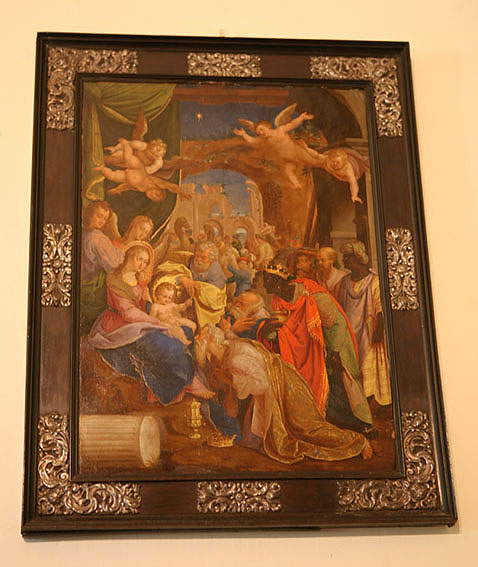
Jacobus di Marsella, "Adoration of the Magi" (57,5 x cm)
Pamplona Cathedral
The original fresco copied on this copper was painted by Federico Zuccaro in 1564 commissioned by the Grimani family for the church of San Francesco della Vigne in Venice. However (as usual), average an engraving between the original and the copy. That is, the direct graphic source is not Zuccaro's painting, but an engraving by Cornelis Cort from around 1571-1572. Zuccaro was an Italian painter and art theorist who also worked in Spain at the request of Philip II for the decoration of El Escorial and Cort was a Dutch artist who lived for years in Rome and engraved much of the work of Zuccaro and other Italian painters.
With respect to Zuccaro's original, Cort's engraving introduces variants in the backgrounds and in the issue of characters. He adds some details, such as the delicate cup with lid, a gift from the king who is kneeling in the foreground.
Jacobus de Marseille keeps the composition the same as in the engraving but introduces new changes in the backgrounds, adding numerous characters and angels that even seem to be taken from other engravings by Cornelis Cort himself. We can imagine him in his studio leafing through different prints and choosing details from here and there to transfer them to his work. This painter, although lacking in originality, achieves in this copy very good qualities, especially in the main figures. From the black and white of the engraving he moves on to a colorful and brilliant painting.
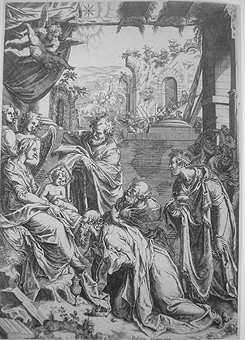
Cornelis Cort, "Adoration of the Magi" (1571-1572)
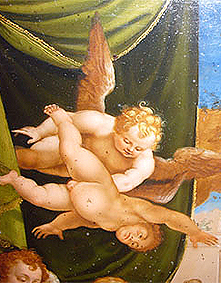
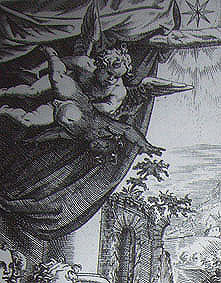
Detail of the angels in the "Adoration of the Magi" in the cathedral of Pamplona, and detail of the engraving of the same topic by Cornelis Cort.
Copper paintings emerged in Renaissance Italy in an environment where there was a taste for experimenting with new modes and techniques. Flemish artists soon developed a market for painted copper, parallel to that of Rome, which reached semi-industrial dimensions and flooded the whole of Europe and America with these small paintings. The great centers of production are the same as those of the engravings, Rome and the Netherlands, and it is plausible to suppose the relationship between the commercial export networks and even the entrepreneurs of both. The small format and the hardness of the material made them easily transportable. On the back they usually bear the signature of the author, the workshop and the marks of the exporting city that guaranteed authenticity to the client. They were works of a domestic nature, suitable for secluded spaces and private homes. In the case of churches, the most appropriate place, where today the best collections are located, are the sacristies. In this sense in the Cathedral of Pamplona the rule is fulfilled.
Copper as a support for painting has a series of very appreciable qualities. The copper plates were bought already polished and prepared for the work, with the consequent cheapening of the process, so that it was a common support in the workshops (not only of "artisan painters" but also in those of the great painters such as Rembrandt, El Greco, Murillo...). It has the advantage of not being affected by humidity or insects and does not require such a complex preparation as canvases. But the most appreciated quality refers to the colors; as copper is a rigid and non-absorbent surface, the pigmentation is intense with saturated colors. According to the restorer Cristina Morilla: An intense ultramarine blue that defines a ceiling, or the mantle of a character on a canvas, for example, has half the intensity of the same motif painted on a copper plate.
Copper plate also requires very little paint to obtain the colors the artist desires. This quality allows the painter to use miniaturist techniques, and to reflect a great amount of details with a precious realism.
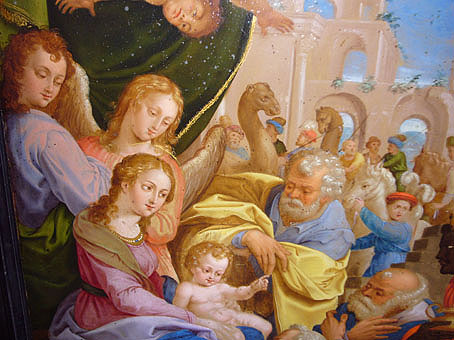
Detail of the Virgin and Child with St. Joseph
As can be seen in the illustrations, Jacobo de Marsella knew how to take advantage of these possibilities. Vivid colors, intense blues, yellows, reds, golds, and delicacy in the details, as in the lace that peeks out from the neck of the Virgin's dress, the pearl necklace, etc.
Neither of the author, nor of the date, nor of the circumstances by which it has arrived at the Cathedral we can contribute data. We can suggest as a hypothesis of work for a later research that it is a painter from a Roman workshop of the 17th century and that it arrived at the Cathedral in the luggage of a bishop or canon on his return from a trip to Rome.
bibliography
BRUQUETAS, R., Técnicas y materiales de la pintura española en los siglos de oro, Madrid, Fundación de Apoyo a la Historia del Arte Hispánico, 2002.
ECHEVERRÍA GOÑI, P. L., "Presencia de Rafael, Miguel Ángel y otros maestros renacentistas en la catedral de Pamplona a través del grabado y de la copia" in programs of study sobre la catedral de Pamplona in memoriam Jesús Mª Omeñaca, Pamplona, Chair Patrimonio y Arte Navarro Universidad de Navarra, 2006, pp. 167-188.
FERNÁNDEZ PARDO, F., coord., Pintura Flamenca Barroca(Cobres, XVII century), San Sebastián, 1996.
GARCÍA GAINZA, M. C., M., ORBE SIVATTE, A., DOMEÑO, J. J., AZANZA LÓPEZ, Catalog Monumental de Navarra, v. *** Merindad de Pamplona, Pamplona, Government of Navarra, Archbishopric of Pamplona, University of Navarra, 1997.
MORILLA, C., "Painting on copper", Descubrir el arte, Year VI nº 39 May 2002, pp. 86-87.
